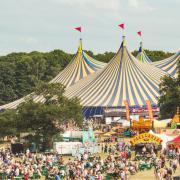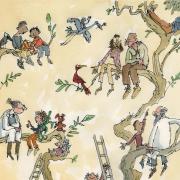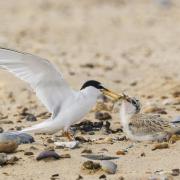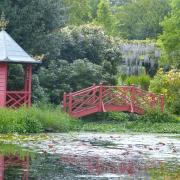Our ancient churches hold centuries of local history and human stories. And for the past 50 years the unsung heroes of Suffolk Historic Churches Trust have been caring for them.
It’s a frantic world out there, but there’s an antidote here in Suffolk where some of the country’s finest church buildings can be found. Many are open daily for visitors to simply wander in to slow life's pace, or to marvel at the sheer diversity of architecture and furnishings from centuries of change.
Regular congregations may be declining but musical concerts, quiz nights and flower festivals continue in a time-honoured way, while some churches now host food banks, lunch clubs and warm spaces for tough times. And there’s another way churches can enrich people’s lives. They can be centres of learning and discovery for all ages. (Full confession: As a former English Heritage support officer, I created the Angels & Pinnacles project for that very purpose).

One of my best moments in a church was the chance to get up close to the angels in the 15th century roof at St John the Baptist Needham Market. No room here for the full story – you need to go to Simon Knott’s excellent website on Suffolk churches for that. But suffice to say the recently-restored double hammerbeam roof is one of the finest in England and, best of all, it remained hidden by a plaster ceiling until the late 19th century when the splendidly-carved angels were added.
Another heart-stopping moment for me was to wander into Wingfield St Andrew, around the time in 2012 they discovered Richard III’s remains under a Leicester car park, only to find the tomb of his sister. She was the wife of John de la Pole, Duke of Suffolk and their son was named by Richard III as his heir. John’s mother was none other than Alice Chaucer, grand-daughter of the poet Geoffrey Chaucer. If only I’d known that while studying the Canterbury Tales for A level!

Learning about Henry VIII and his wives, it would have added a new dimension to know that his illegitimate son Henry FitzRoy lay in the chancel at Framlingham. I could then have discovered more about the powerful Dukes of Norfolk whose elaborate tombs grace the chancel they made as their shrine at St Michael’s – all easily as compelling as the famous castle next door. The tomb of Henry’s sister, Mary Tudor at St Mary’s Bury St Edmunds is a much simpler affair.
Soaring showpiece churches such as Long Melford, Lavenham, Southwold and Blythburgh were built on the back of the woollen cloth and herring wealth in 14th and 15th century Suffolk. Yet, grandeur aside, once bitten by the churches bug, you’ll find your own special and memorable places. Sometimes isolated, sometimes tiny but always full of memories and monuments, there are gripping stories about the people who built and furnished them – the stone masons, carvers and painters – and those who cared for them and populated them when they were built centuries ago.

At Kedington St Peter and St Paul, it’s hard to know where to look first but, among the elaborate Barnardiston monuments dating back to the Middle Ages is one for family member Grissel, “too deare to frendes, too much of men desier’d”. She’s a must-see.
Following the 15th century heyday, the Victorians went full pelt on restoring neglected churches as well as filling them with pews that were never going to be full for regular worship. It’s scarcely believable that rector’s wife Mildred Holland spent seven years recreating the splendour of a typical 15th century angel roof at Huntingfield St Mary, mostly laying on her back, but it’s there for all to see and a reminder of how colourful medieval churches would have been. She’s said to have used 225 books of gold leaf for the nave alone. 
Historians and church crawlers can get quite picky about gaudy glass and other showy touches of some Victorian and later designers. I personally love the surprise of entering St John the Baptist at Lound and being dazzled by the work of architect Sir Ninian Comper. Then there are the quirky touches that tell us so much about humanity. You have to wonder why the rector’s brother at Wortham St Mary chose to carve a walrus on the bench end.

The medieval glass in Long Melford church is unforgettable, but a 'glass tour' of other Suffolk churches might lead you to such delightful examples as Mary Anne Jolly, for 18 years the “diligent cleaner of this church” tucked away in the west end of Mildenhall St Mary. Were there any men on the cleaning rota I wonder?
What is truly remarkable is that churches are self-financing, relying on donations, legacies and all-important grants from organisations such as the Suffolk Historic Churches Trust, which is marking 50 years since its founding in 1973. Perhaps more extraordinary is the army of gallant volunteers who, in the words of Diana Fawcus, churchwarden at Flowton St Mary, “keep the roof on and the door open”.
The unsung heroes of our churches
Diana Fawcus has been churchwarden at Flowton St Mary for almost 30 years. Her reason for doing it is straightforward and simple: “I love the church and I love the community.” She has seen important changes to the 600-year-old building, including the removal of pews from the west end to create a space for quiz nights, a monthly coffee morning, a monthly craft and chat, and childrens’ workshops at Christmas, Easter and harvest. More recently, the church has raised money for a new kitchen extension and toilet, a project driven by Diana’s fellow churchwarden, Margaret Laflin, who sadly died just over two years ago. “People come for weddings or funerals and always ask, have you got a toilet? And it’s so much easier for making coffee because previously all the water had to be carried across in 5-litre containers.”

Says Diana: “Congregations might be small but our lay reader, Mary Carter, often says, ‘it doesn’t matter if there’s only two. Can’t you feel it? There’s all the angels here'. And you do actually think of the prayers that have been said here – people who’ve been thankful for joyous things, people who’ve asked for help in horrible times and you do sort of sense that.
“Sometimes when I’ve been doing flowers, people in the village who don’t come to church, do come and just sit in here.” Does she worry about who will come after her? “Well there’s nothing you can do. They do say no one is indispensable and so many churches don’t have any wardens at all do they?”
Custody of treasures
Keeping the door open daily is important at Wenhaston too, not least because one of Suffolk’s greatest church treasures is there, attracting visitors from all over the world since it was rescued over 130 years ago. This is the Doom of Judgement Day, painted on a series of boards around 1502 and one of the most perfect survivals of its kind.
Churchwarden Jonathan Alder never tires of the story of how the boards lay in the churchyard in 1892 headed for the bonfire, until the rain washed off the whitewash of the Reformation revealing this 17ft x 8 ft prize of a painting, attracting the likes of Benjamin Britten and EM Forster to go and admire it.

Now he wants to safeguard this remarkable survivor for future generations and is in discussion about where it would be best located in the church. It can't be moved to what would have been its original location over the chancel arch, now with elaborate Victorian carving. It’s a project he is undertaking on top of his regular duties. For the past three years he's been sole churchwarden following the retirement of the previous warden.
“It’s certainly not something I aspired to,” says Jonathan, who has also been church organist for the past 20 years. "But I’d retired after 36 years as a lawyer, and had been co-opted on to the PCC about four years ago to deal with the sale of the church room next door. That’s freed up the funds to start looking at issues like the chancel roof where the tiles on the south side frosted and cracked.
“I think rural churches really do struggle. People in the village and local area expect the church to be here for weddings and funerals, and for the church to be open. Few understand that only a very small number of people run these places, many of whom are in their eighties. The thing that worries me is how sustainable is this going forward?”
50 years of caring
Since its beginning 50 years ago, the Suffolk Historic Churches Trust has raised almost £7million to help with repair and maintenance of the county’s churches. The trust is non-denominational so all churches, chapels and meeting houses – around 600 - are eligible to apply for grants.
The inspiration for the trust, launched in December 1973, came from the 11th Duke of Grafton, supported by philanthropist the Hon Jill Ganzoni, Alfred Williams of Haughley Park and well-known Suffolk historian Norman Scarf. Geoffrey Probert, chairman since 2018 and a trustee for 12 years, understands the challenges of running churches in a more secular society with declining congregations, but says: “I am constantly amazed by shining examples of small villages to rally round and raise huge sums of money when their church building needs some massively expensive repair.”
He believes the key to survival is for churches to serve the wider community outside of worship, so that, in turn, “the community will support them in their hour of financial need when the roof starts to leak or the tower wall to crack”.
Geoffrey has been determined to protect churches from the “curse of lead theft” that was so predominant in the summer of 2015 and has persuaded many to install roof alarms with grant aid from the SHCT so that “today over 90 per cent of Suffolk lead-roofed churches are protected”. He stresses it is all a collective effort. The trust derives its income from membership of its Friends organisation, donations, grants and legacies and in particular from the annual sponsored Ride and Stride, held in September each year. Suffolk pioneered this nationwide event in 1982 and Geoffrey added a sister event, Pedal and Drive, when he became chairman.

Until now, the Trust has been focused primarily on grant giving, often 'priming the pump' to encourage other grant-givers. Geoffrey envisages a growing role in advising churches on applying for other grants “in a world in which our churchwardens find themselves competing with large charities and heritage sites for scarce funding”.
The trust plans to mark its 50th anniversary with a special service at St Edmundsbury Cathedral in September “when we will aim to pack the cathedral with two representatives from every church and chapel in Suffolk for a great multi-denominational service of celebration”.



























